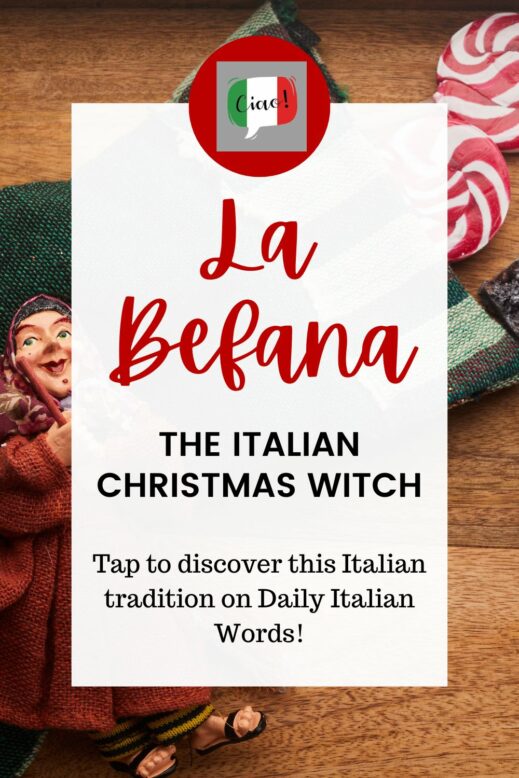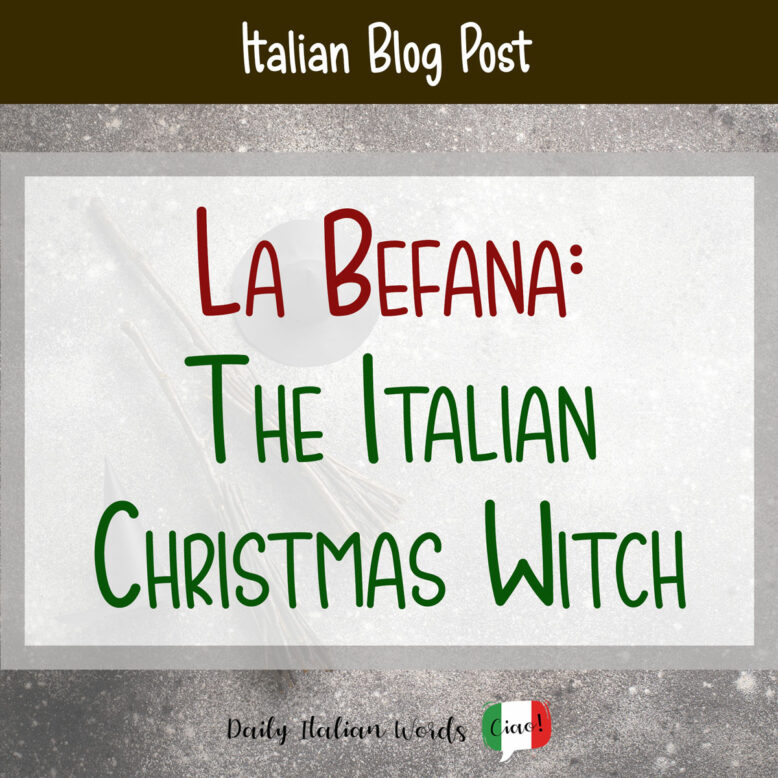Most people in the English speaking world strictly associate witches with Halloween. In our minds, they are dark clad figures with flying brooms, ragged clothing, craggy features, and perhaps, a black cat for company.
As far as I know, Italy is the only country in the world where witches are also closely linked to the Christmas tradition. And not just witches in general – a specific witch who goes by the name of Befana.

Much like Santa Claus, she is said to visit the houses of children on the night of January 5th, the Eve of the Epiphany, leaving sweets, nuts and fruit in the stockings of the good and black coal, onions and garlic in those of the naughty.
In this article, I would like to share the unique Italian Christmas tradition of the Befana with you. You will learn about the history and legends surrounding the Befana, her hometown, and how she is celebrated across Italy.

Who is la Befana?
La Befana (la = the) is an old witch who flies around Italy on the Eve of Epiphany (January 5th) bringing sweets and gifts to good children and coal, onion and garlic to naughty children. In exchange, many families leave her a glass of wine and a plate of sausages and broccoli. (It seems that she doesn’t have the sweet tooth of Santa Claus!)
La Befana porta regali ai bambini buoni e carbone ai bambini cattivi.
The Befana brings gifts to good children and coal to naughty children.
She wears a patched skirt and an old shawl. Her hair is unkempt and scraggly, and it is more than obvious that she has not been to the dentist in many a year!
Despite her revolting appearance, she is actually a kind witch, only punishing children who have misbehaved throughout the year.
The history behind the Befana is even more twisted than the haggard bristles of her broomstick.
Many historians credit her existence to the Roman goddess Strina, who bestowed gifts called strenae. It is thought that the name Befana could have derived from this word for gifts.
A more widely held belief is that her origins come from the Feast of Epiphany, as the words epiphany and Befana are etymologically very similar.
La Befana porta i suoi regali alla vigilia dell’Epifania.
The Befana brings her gifts on the eve of the Epiphany.
The birth of the Befana is also thought to have pagan origins. She has been connected to Nicnevin, the Scottish Queen of the Fairies, and to even more ancient Neolithic traditions.
The reality is that nobody really knows how the Befana tradition was born. All we know for sure is that it has a steadfast place in the celebration of Christmas in modern day Italy.

The Legend of la Befana
The original legend of the Befana, as with most ancient folk tales, has split into a number of versions, all of which share a common theme: an old housekeeper who goes on the futile search for the baby Jesus after refusing to join the Re Magi (Wise Men) on their journey. The most popular version goes as follows:
There once was an old woman named Befana. She was renowned as the best housekeeper in the village. One day, she is visited by the Three Wise Men (the Magi) who are on a journey to find the Son of God. They ask her if she knows the way, but she does not. Being a kind woman, she invites the Magi to stay in her home for the night. Grateful for her kindness, they ask the Befana to accompany them on their journey, but she refuses, saying that she has too much work to do. After her guests leave, she has a change of heart, packs a number of gifts and sweets for baby Jesus, and heads out to follow the Magi. Sadly, she never finds the Magi nor the baby Jesus. To this day, she continues to search for the Son of God, leaving gifts for children in her path. She does this because she knows Jesus lives in the hearts of all children.
The Befana Festival in Urbania
In the past decade, the town of Urbania in the Marche region of Italy has become the official home of the Befana.
In this town, they have their own special way of celebrating the Day of Epiphany. Hundreds of men and women dress up as the old Christmas witch, flooding the streets and hanging from bell towers in the main square to entertain the visitors and children.
Amongst the many aspiring befanas is the ‘real’ Befana, who invites children to sit on her lap and make a special request. Requests range from world peace to the simple plea not to receive a piece of coal in their stockings. For all their similarities, you could almost call la Befana the St. Nicholas of Italy!
La Befana Vien di Notte: A Popular Poem
Here is a popular nursery rhyme (filastrocca) about the Befana known across Italy.
La Befana vien di notte
con le scarpe tutte rotte
col vestito alla romana:
Viva viva la Befana!
La Befana comes at night
with her broken shoes
with her roman clothes
Long live la Befana!
And below is the musical adaptation La Befana Trullalà by Gianni Morandi.
The Befane Races (La Regata delle Befane)
There are few things more amusing than watching five ageing Italian gentlemen dressed up as old hags desperately trying to win a mascareta boat race along the Grand Canal in Venice!
The Befana Races (or La Regata delle Befane in Italian) is a yearly event held on the Day of Epiphany. Thousands of locals and tourists line up along the canals to see the short sprint between the curve in the Grand Canal and the Rialto Bridge take place.
There is only one main rule the rowers must follow: you must dress up in Befana garb. Since the canal isn’t very wide, only the five best rowers may take part.
Visitors can also look forward to free drinks and candies, market stalls, and of course, the stunning views of Venice.
Below is a video published by Leonardo Orlandi about the Regata delle Befane 2018. (You can jump to minute 5 or 6 to see the participants and the start of the race.)

Heather Broster is a graduate with honours in linguistics from the University of Western Ontario. She is an aspiring polyglot, proficient in English and Italian, as well as Japanese, Welsh, and French to varying degrees of fluency. Originally from Toronto, Heather has resided in various countries, notably Italy for a period of six years. Her primary focus lies in the fields of language acquisition, education, and bilingual instruction.


